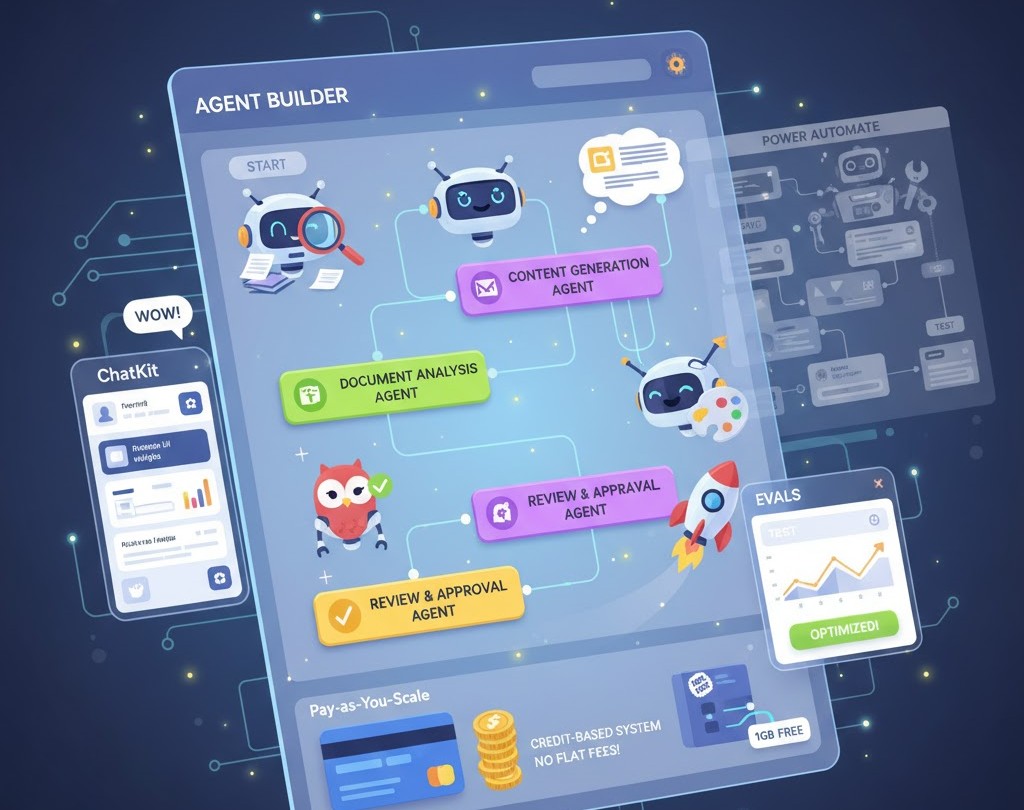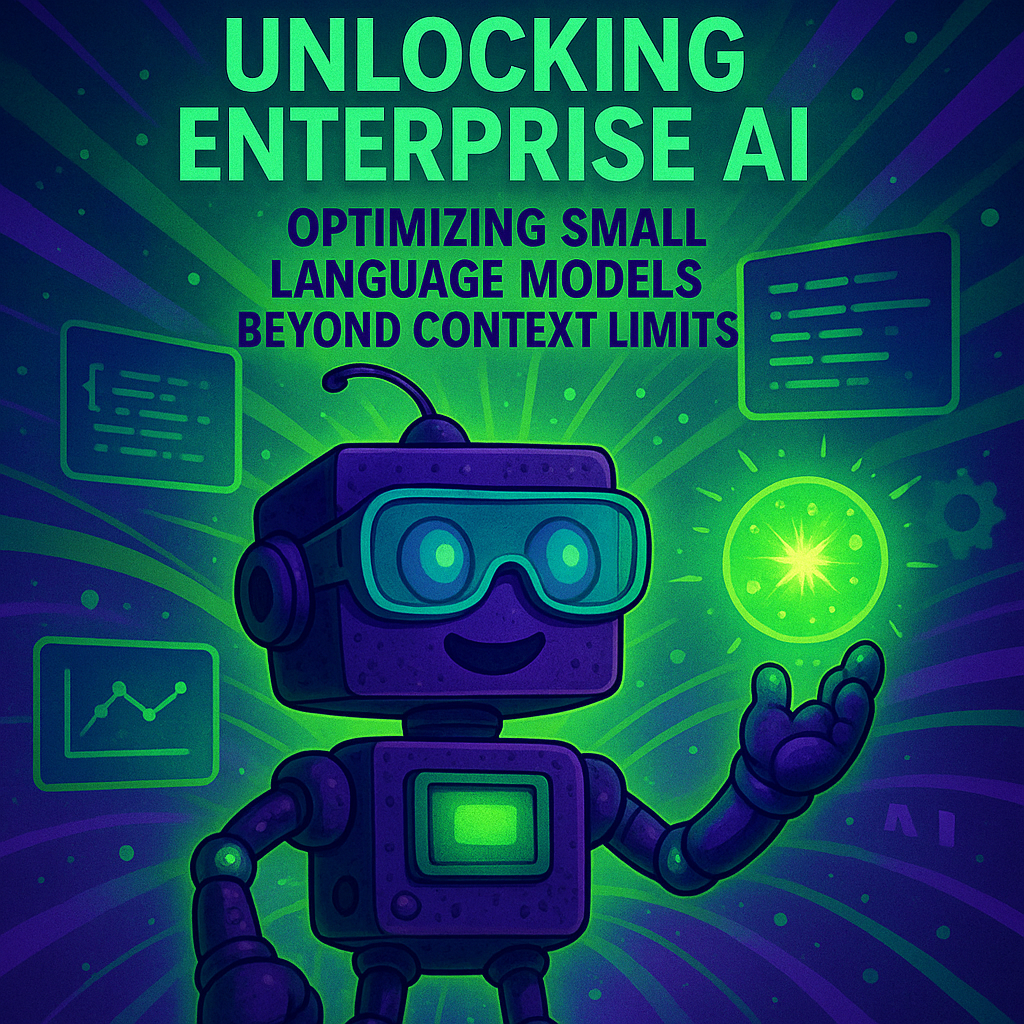OpenAI's New Agent Builder: A Game-Changer for Enterprise Automation

What is OpenAI's AgentKit and Agent Builder?
OpenAI’s AgentKit is a new suite of tools that makes building, deploying, and optimizing AI agents much easier. It unifies fragmented workflows—no more juggling orchestration code, eval pipelines, and manual connectors. Instead, AgentKit provides building blocks that work together:
- Agent Builder: A visual canvas for designing and running multi-agent workflows
- Connector Registry: Centralized hub for managing connectors across products, enabling enterprise control and governance
- ChatKit: Embeddable, customizable chat UIs for agent interactions
- Evals: Tools for datasets, grading, and prompt optimization—delivering measurable performance gains
This ecosystem runs inside the OpenAI platform, making it accessible to anyone already using an OpenAI developer account.
Pricing Model: Pay-as-You-Scale
AgentKit follows OpenAI’s standard usage-based pricing. Instead of flat SaaS fees, costs scale directly with consumption:
- No flat fees: Pay only for compute, tokens, and data usage
- Credit-based system: Credits start at $5, with optional auto-recharge to prevent interruptions
- Automatic recharge: Configure thresholds to avoid interruptions
- Vector storage: Includes 1GB free capacity, then $0.10/GB/day beyond that
This credit-based flexibility ensures businesses only pay for what they use while retaining the ability to scale.
The ChatKit Revolution
ChatKit makes embedding AI-powered chat interfaces simple. Instead of weeks of frontend work, developers can add:
- Real-time, streaming model responses
- Rich, interactive widgets (forms, media, data visualizations)
- Branded, theme-matched chat experiences
Early adopters like Canva and HubSpot report deploying support agents in hours, not weeks, transforming how users engage with their systems.
Vector Storage and RAG
Agent Builder includes first-class support for vector embeddings and Retrieval-Augmented Generation (RAG):
- Upload and manage organizational documents
- Build hybrid search (semantic + keyword)
- Keep knowledge bases updated automatically
With 1GB of included storage, smaller teams can experiment at no cost, while enterprises can expand beyond that at $0.10/GB per day.
Multi-Agent Workflows
The most transformative feature is multi-agent orchestration. Teams can design workflows where different agents specialize:
- Analysis Agent → Processes and extracts info from documents
- Content Generation Agent → Produces articles, reports, or marketing assets
- Image Agent → Generates visuals
- Approval Agent → Handles human review steps
- Publishing Agent → Distributes to CMS or platforms
This mirrors human teamwork and enables sophisticated automation.
Implementation Considerations
Getting Started
- Sign up via platform.openai.com/agent-builder
- Load credits (e.g., $10 to start testing)
- Experiment with templates or build from scratch
Integration Strategies
AgentKit could potentially complement tools like:
- Make.com → complex integrations
- Power Automate → Microsoft ecosystem workflows
- Webflow → publishing content
- Teams → approval & notifications
Cost Management Best Practices
- Start without auto-recharge enabled
- Monitor early usage closely
- Regularly review vector storage consumption
What This Means for the Market
AgentKit introduces AI-native automation—not just connecting services but making workflows intelligent. Compared to traditional tools, it offers:
- Smarter decision-making
- Handling of unstructured data
- Built-in evals for reliability
- Multi-agent orchestration
This positions OpenAI as a direct competitor to enterprise automation platforms, but with deeper intelligence baked in.
Looking Ahead
AgentKit signals a shift toward intelligent automation. We can expect:
- Better reasoning and memory in workflows
- Seamless collaboration between AI agents and humans
- Richer natural language interfaces for business users
- Faster iteration cycles with built-in evals and versioning
For businesses, AgentKit isn’t just another automation tool—it’s a practical, scalable path to embedding advanced AI into daily operations.
The future of automation is not just about tasks being automated, but about agents reasoning, collaborating, and adapting in real-time. OpenAI’s AgentKit is the toolkit that makes this vision achievable.
What is OpenAI's AgentKit and Agent Builder?
OpenAI’s AgentKit is a new suite of tools that makes building, deploying, and optimizing AI agents much easier. It unifies fragmented workflows—no more juggling orchestration code, eval pipelines, and manual connectors. Instead, AgentKit provides building blocks that work together:
- Agent Builder: A visual canvas for designing and running multi-agent workflows
- Connector Registry: Centralized hub for managing connectors across products, enabling enterprise control and governance
- ChatKit: Embeddable, customizable chat UIs for agent interactions
- Evals: Tools for datasets, grading, and prompt optimization—delivering measurable performance gains
This ecosystem runs inside the OpenAI platform, making it accessible to anyone already using an OpenAI developer account.
Pricing Model: Pay-as-You-Scale
AgentKit follows OpenAI’s standard usage-based pricing. Instead of flat SaaS fees, costs scale directly with consumption:
- No flat fees: Pay only for compute, tokens, and data usage
- Credit-based system: Credits start at $5, with optional auto-recharge to prevent interruptions
- Automatic recharge: Configure thresholds to avoid interruptions
- Vector storage: Includes 1GB free capacity, then $0.10/GB/day beyond that
This credit-based flexibility ensures businesses only pay for what they use while retaining the ability to scale.
The ChatKit Revolution
ChatKit makes embedding AI-powered chat interfaces simple. Instead of weeks of frontend work, developers can add:
- Real-time, streaming model responses
- Rich, interactive widgets (forms, media, data visualizations)
- Branded, theme-matched chat experiences
Early adopters like Canva and HubSpot report deploying support agents in hours, not weeks, transforming how users engage with their systems.
Vector Storage and RAG
Agent Builder includes first-class support for vector embeddings and Retrieval-Augmented Generation (RAG):
- Upload and manage organizational documents
- Build hybrid search (semantic + keyword)
- Keep knowledge bases updated automatically
With 1GB of included storage, smaller teams can experiment at no cost, while enterprises can expand beyond that at $0.10/GB per day.
Multi-Agent Workflows
The most transformative feature is multi-agent orchestration. Teams can design workflows where different agents specialize:
- Analysis Agent → Processes and extracts info from documents
- Content Generation Agent → Produces articles, reports, or marketing assets
- Image Agent → Generates visuals
- Approval Agent → Handles human review steps
- Publishing Agent → Distributes to CMS or platforms
This mirrors human teamwork and enables sophisticated automation.
Implementation Considerations
Getting Started
- Sign up via platform.openai.com/agent-builder
- Load credits (e.g., $10 to start testing)
- Experiment with templates or build from scratch
Integration Strategies
AgentKit could potentially complement tools like:
- Make.com → complex integrations
- Power Automate → Microsoft ecosystem workflows
- Webflow → publishing content
- Teams → approval & notifications
Cost Management Best Practices
- Start without auto-recharge enabled
- Monitor early usage closely
- Regularly review vector storage consumption
What This Means for the Market
AgentKit introduces AI-native automation—not just connecting services but making workflows intelligent. Compared to traditional tools, it offers:
- Smarter decision-making
- Handling of unstructured data
- Built-in evals for reliability
- Multi-agent orchestration
This positions OpenAI as a direct competitor to enterprise automation platforms, but with deeper intelligence baked in.
Looking Ahead
AgentKit signals a shift toward intelligent automation. We can expect:
- Better reasoning and memory in workflows
- Seamless collaboration between AI agents and humans
- Richer natural language interfaces for business users
- Faster iteration cycles with built-in evals and versioning
For businesses, AgentKit isn’t just another automation tool—it’s a practical, scalable path to embedding advanced AI into daily operations.
The future of automation is not just about tasks being automated, but about agents reasoning, collaborating, and adapting in real-time. OpenAI’s AgentKit is the toolkit that makes this vision achievable.
Related Blog Posts

Unlocking Enterprise AI: Optimizing Small Language Models Beyond Context Limits
.png)
Keeping QuickBooks Desktop Current in a Multi‑Session World: A Deep Dive into QB‑Flow


.png)
